Is there a way to fill everything but a polygon in ggplot2?
This method may be a bit unorthodox, but anyway:
library(mapdata)
library(ggmap)
library(ggplot2)
library(raster)
ggmap_rast <- function(map){
map_bbox <- attr(map, 'bb')
.extent <- extent(as.numeric(map_bbox[c(2,4,1,3)]))
my_map <- raster(.extent, nrow= nrow(map), ncol = ncol(map))
rgb_cols <- setNames(as.data.frame(t(col2rgb(map))), c('red','green','blue'))
red <- my_map
values(red) <- rgb_cols[['red']]
green <- my_map
values(green) <- rgb_cols[['green']]
blue <- my_map
values(blue) <- rgb_cols[['blue']]
stack(red,green,blue)
}
Peru <- get_map(location = "Peru", zoom = 5, maptype="satellite")
data(wrld_simpl, package = "maptools")
polygonMask <- subset(wrld_simpl, NAME=="Peru")
peru <- ggmap_rast(Peru)
peru_masked <- mask(peru, polygonMask, inverse=T)
peru_masked_df <- data.frame(rasterToPoints(peru_masked))
ggplot(peru_masked_df) +
geom_point(aes(x=x, y=y, col=rgb(layer.1/255, layer.2/255, layer.3/255))) +
scale_color_identity() +
coord_quickmap()

Via this, this, and this questions/answers.
What I am looking for is the surroundings with a transparent fill
layer and Peru with alpha=1
If first thought this is easy. However, then I saw and remembered that geom_polygon does not like polygons with holes very much. Luckily, geom_polypath from the package ggpolypath does. However, it will throw an "Error in grid.Call.graphics(L_path, x$x, x$y, index, switch(x$rule, winding = 1L..." error with ggmaps default panel extend.
So you could do
library(mapdata)
library(ggmap)
library(ggplot2)
library(raster)
library(ggpolypath) ## plot polygons with holes
Peru <- get_map(location = "Peru", zoom = 5, maptype="satellite")
data(wrld_simpl, package = "maptools")
polygonMask <- subset(wrld_simpl, NAME=="Peru")
bb <- unlist(attr(Peru, "bb"))
coords <- cbind(
bb[c(2,2,4,4)],
bb[c(1,3,3,1)])
sp <- SpatialPolygons(
list(Polygons(list(Polygon(coords)), "id")),
proj4string = CRS(proj4string(polygonMask)))
sp_diff <- erase(sp, polygonMask)
sp_diff_df <- fortify(sp_diff)
ggmap(Peru,extent="normal") +
geom_polypath(
aes(long,lat,group=group),
sp_diff_df,
fill="white",
alpha=.7
)



